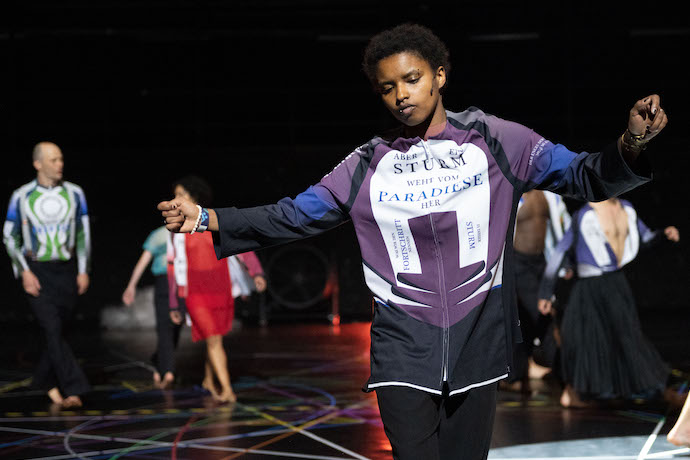
By Esmee Wright
Sadlers Wells,
London
Anne Teresa De Keersmaeker’s Exit Above – after the tempest, which received its UK debut at Sadler’s Well this month, is a confronting – yet notably communal – piece. Inspired by pop music, a genre Keersmaeker has worked with numerous times, Exit Above – after the tempest sees Keersmaeker looking further back to its origins in blues, and to her own choreographic base: walking.
- Read: Dance Umbrella 2024 | Q&A with artistic director Freddie Opoku Addaie on this year’s line-up
- Read: Review of Rite of Spring | Stravinsky’s formidable work meets the Bharatanatyam school of dance
Developing from an opening enigmatic solo by Solal Mariotte (a duet really with the diaphanous fabric which spins around him, hides him and almost seems to hold him in its grasp as he struggles with some invisible force), Exit Above – after the tempest is a wave of crests and quiet moments. Shakespeare’s The Tempest is a subtle reference point. It came to mind for Keersmaeker after she realised the two key subjects of blues songs: lost loves, and the destruction wrought by floods on the Mississippi delta, and is seen mostly in Mariotte’s flighty Arial and Nina Godderis’s Prospero, who grabs control of the music from the musicians among the cast.
- Read: Preview of Circa’s Duck Pond | Q&A about the acrobatics troupe’s new production
- Read: What is Circa? | Our guide to the theatrical acrobatics troupe who often blend circus with classical music
Meskerem Mees, an up-and-coming Flemish singer-songwriter provides the vocal link with the audience, though she too joins the dancers on stage in their choreography. So does guitarist Carlos Garbin, originally a dancer in fact, who became obsessed with the guitar after learning to play The Beatles for a performance a decade ago, another sign of the importance of intertwining music and movement in this production. The sense of propulsion shifts from singer and guitarist into the group and back again throughout.
- Read: Review of Becoming Shades | a symphony of music, physical theatre, aerial acrobatics, fire, dance and mime
- Read: Who is Meredith Monk? | Our guide to the American interdisciplinary artist
The development of the choreography, too, sees highs and lows, from manic group movement which will make you want to get up and dance yourself, to sudden, confronting silences. The fourth wall is non-existent as dancers gaze, bark at and even mime vomiting over the audience. Attention is drawn to the theatricality of the piece, and its physicality – a physicality foregrounded as dancers breathe dramatically, and Jacob Storer dances a wonderful solo, in which the rushing sound of the fabric of his skirt is as much a sound track as the ambient noise. ![]()